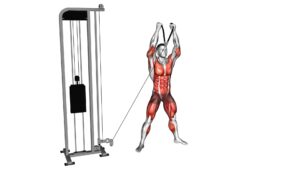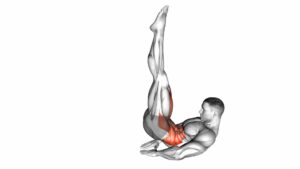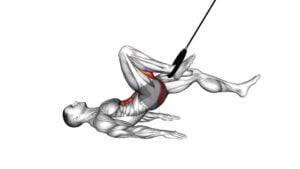Twist Hip Lift – Video Exercise Guide & Tips

Looking to add some variety to your workout routine?
Watch This Exercise Video
Check out the Twist Hip Lift, a dynamic exercise that targets your core and improves flexibility.
In this video exercise guide, you'll find step-by-step instructions and helpful tips to ensure proper form and technique.
Whether you're a beginner or looking to challenge yourself, modifications and tips for increasing difficulty are included.
Get ready to twist and lift your way to a stronger, more toned body.
Let's get started!
Key Takeaways
- The Twist Hip Lift targets core muscles, improving stability, strength, and posture.
- Proper form and technique include lying on your back, engaging the core, and twisting the torso while maintaining a straight line from shoulders to knees.
- Common mistakes to avoid when performing the Twist Hip Lift include lifting hips too high, relying on momentum instead of core engagement, and twisting too forcefully.
- Modifications for beginners include using a stability ball or rolled-up towel for support, starting with easier variations, and gradually progressing to the full exercise.
Benefits of the Twist Hip Lift
To maximize your results with the Twist Hip Lift, it's important to understand the numerous benefits that this exercise offers.
The Twist Hip Lift is a core strength training exercise that targets multiple muscle groups, including the abs, obliques, and lower back. This exercise helps to improve your overall core stability and strength, which is essential for maintaining proper posture and preventing injuries.
One of the great things about the Twist Hip Lift is that it can be modified to suit your fitness level and goals. There are several variations of this exercise that you can try, such as adding weights or using a stability ball. These variations allow you to challenge yourself and continue making progress as your strength improves.
In addition to improving core strength, the Twist Hip Lift also helps to improve your balance and coordination. By engaging your core muscles and twisting your hips, you're training your body to move in a controlled and coordinated manner. This can be particularly beneficial for athletes who require quick and agile movements in their sports.
Proper Form and Technique
To perform the Twist Hip Lift with proper form and technique, follow these steps.
- Start by lying on your back with your knees bent and feet flat on the ground.
- Place your hands behind your head for support.
- Engage your core and lift your hips off the ground, forming a straight line from your shoulders to your knees.
- As you lift, exhale and twist your torso to one side, bringing your elbow towards the opposite knee.
- Return to the starting position and repeat on the other side.
Maintaining proper form is crucial to maximize the effectiveness of the Twist Hip Lift and prevent injuries.
- One common error is lifting the hips too high, which can strain your lower back.
- Remember to lift only as far as you can while maintaining a straight line from your shoulders to your knees.
- Another mistake is using momentum to twist your torso instead of engaging your core muscles.
- Focus on using your abdominal muscles to initiate the twist, rather than relying on your arms or momentum.
For beginners, modifications can be made to make the exercise more accessible.
- If you find it challenging to lift your hips off the ground, you can start by performing the exercise with your hips resting on a stability ball or a rolled-up towel.
- This will provide additional support and make it easier to engage your core.
- As you become more comfortable and stronger, you can gradually progress to performing the Twist Hip Lift without any modifications.
- Remember to always listen to your body and work at your own pace.
Common Mistakes to Avoid
When performing the Twist Hip Lift exercise, it's important to ensure you're maintaining proper form to avoid common mistakes. By watching the proper form demonstration in the video guide, you can learn how to execute the exercise correctly.
Additionally, be aware of common errors such as twisting too forcefully or relying on momentum, and make corrections as needed to maximize the effectiveness of the exercise.
Proper Form Demonstration
Ensure proper form and avoid common mistakes during the Twist Hip Lift exercise to maximize its effectiveness and prevent injury. Here are some key tips to help you maintain proper form:
- Start by lying flat on your back with your knees bent and feet flat on the ground.
- Place your hands behind your head, keeping your elbows wide.
- Engage your core and lift your hips off the ground while twisting your torso to the side.
Maintaining proper form is crucial to reap the benefits of hip mobility exercises like the Twist Hip Lift. By following these tips, you can target your obliques, strengthen your core, and improve your hip mobility.
Remember to listen to your body and start with a weight and difficulty level that's appropriate for you.
Correcting Common Errors
To maximize the effectiveness of the Twist Hip Lift exercise and prevent injury, it's important to be aware of and correct common mistakes.
One common error in Twist Hip Lift is having improper form. Make sure to keep your shoulders aligned with your hips throughout the exercise.
Another mistake is using momentum instead of engaging your core muscles. To correct this, focus on using your abdominal muscles to lift and twist your hips.
It's also important to avoid lifting your legs too high, as this can strain your lower back. Keep your movements controlled and within a comfortable range of motion.
Modifications for Beginners
Start with a few easier variations of the Twist Hip Lift to gradually build strength and technique. Here are some beginner modifications and alternative exercises to help you get started:
- Assisted Twist Hip Lift: Lie on your back with your knees bent and feet flat on the floor. Place your hands on your hips for support. Lift your hips off the ground and twist them to one side, then slowly lower back down. Repeat on the other side. This modification allows you to focus on the twisting motion while providing added stability.
- Bent Knee Twist: Start in the same position as the assisted twist hip lift, but instead of lifting your hips, keep your feet on the ground and focus on twisting your knees from side to side. This exercise helps to activate the obliques and build core strength.
- Standing Twist: Stand with your feet shoulder-width apart and your arms extended in front of you. Twist your torso to one side, keeping your hips facing forward. Return to the starting position and repeat on the other side. This standing variation is a great way to engage your core and work on balance.
Tips for Increasing Difficulty
To increase the difficulty of the Twist Hip Lift exercise, there are a few tips you can follow.
First, consider adding resistance bands to add extra tension to your movements.
Second, you can increase the weight load by using dumbbells or kettlebells.
Lastly, try performing the exercise on unstable surfaces like a balance board or a stability ball to challenge your core stability and balance.
Adding Resistance Bands
Increase the difficulty of the Twist Hip Lift exercise by incorporating resistance bands. Here are three resistance band variations to make the exercise more challenging:
- Mini Band Resistance: Place a mini resistance band around your thighs, just above the knees. This will engage your outer hip muscles more intensely during the exercise.
- Looped Band Resistance: Attach a longer resistance band to a sturdy anchor point, like a pole or door handle. Loop the band around your hips and hold onto the ends. This added resistance will require more effort from your core and glutes.
- Band Pull-aparts: Stand with your feet shoulder-width apart and hold a resistance band with both hands in front of your chest. Pull the band apart sideways, engaging your upper back muscles. This exercise will improve your posture and strengthen your upper body.
Incorporating resistance bands into your Twist Hip Lift routine will help you develop more strength and stability. Don't be afraid to try these variations for a more challenging workout.
Increasing Weight Load
To further challenge yourself during the Twist Hip Lift exercise, consider increasing the weight load. By adding more weight, you can effectively increase the difficulty and continue to progress in your fitness journey.
There are several progression options and advanced variations you can try to maximize the benefits of this exercise. Firstly, you can use a weighted plate or dumbbell and hold it against your chest while performing the hip lift. This will add resistance and engage your core muscles even more.
Another option is to use a barbell across your hips, gradually increasing the weight as you get stronger. Remember to maintain proper form and alignment throughout the exercise to prevent injury.
Keep pushing yourself and enjoy the challenge!
Utilizing Unstable Surfaces
One way to make the Twist Hip Lift exercise more challenging is by incorporating unstable surfaces. This adds an element of balance training and core stability to the exercise, making it even more effective for strengthening your core muscles.
Here are three ways you can utilize unstable surfaces to increase the difficulty of the Twist Hip Lift:
- Using an exercise ball: Place your feet on top of an exercise ball while performing the Twist Hip Lift. This forces your core muscles to work harder to stabilize your body on the unstable surface.
- BOSU ball: Stand on a BOSU ball with one foot while performing the Twist Hip Lift. This not only challenges your core stability but also improves your balance and coordination.
- Foam pad: Place a foam pad under your feet while doing the Twist Hip Lift. The soft and unstable surface of the pad forces your core muscles to engage even more to maintain balance.
Incorporating these unstable surfaces into your Twist Hip Lift routine will take your core training to the next level and help you improve your balance and core stability.
Incorporating the Twist Hip Lift Into Your Workout Routine
Start incorporating the Twist Hip Lift into your workout routine for a more challenging and effective core workout. This exercise not only targets your core muscles but also incorporates rotational movements, which have numerous benefits for your overall fitness.
When it comes to core strength, there are many alternative exercises you can do. However, the Twist Hip Lift stands out because it engages your obliques and deep core muscles while also improving your stability and balance. By adding this exercise to your routine, you'll enhance your core strength and stability, leading to better posture and overall body control.
Incorporating rotational movements in your workouts has several benefits. Firstly, it helps to improve your athletic performance by increasing your power and agility. Rotational movements engage multiple muscle groups, which can enhance your coordination and overall body control. Additionally, these movements can also help to prevent injuries by improving your joint mobility and stability.
To perform the Twist Hip Lift, lie on your back with your knees bent and feet flat on the ground. Place your hands behind your head and lift your shoulders off the ground. Twist your torso to one side, bringing your elbow towards the opposite knee. Return to the starting position and repeat on the other side.
Frequently Asked Questions
How Many Calories Can I Expect to Burn by Doing the Twist Hip Lift?
By doing the twist hip lift, you can expect to burn calories and work your core muscles. However, the exact number of calories burned depends on various factors such as your weight, intensity, and duration of the exercise.
If you're looking for alternative exercises that can help you burn calories, you may consider activities like running, cycling, or high-intensity interval training.
Remember to consult with a fitness professional for personalized recommendations.
Is the Twist Hip Lift Suitable for Individuals With Lower Back Pain?
The twist hip lift can be modified to suit individuals with lower back pain. It's important to listen to your body and make adjustments as needed. If you experience discomfort, consider reducing the range of motion or using a smaller range of motion.
Alternatively, there are other exercises that can target the same muscles without putting strain on your lower back. Speak with a fitness professional to find alternative exercises that are suitable for your condition.
Can I Do the Twist Hip Lift if I Have a Pre-Existing Hip Injury?
If you have a pre-existing hip injury, it's important to be cautious when attempting the twist hip lift exercise. It may be necessary to modify the exercise or find alternative exercises that put less strain on your hip.
It's recommended to consult with a medical professional or a certified trainer who can provide you with specific modifications or alternative exercises that are safe for your condition.
How Often Should I Incorporate the Twist Hip Lift Into My Workout Routine for Optimal Results?
To achieve optimal results, it's important to consider your workout frequency when incorporating the twist hip lift into your routine.
The twist hip lift is a challenging exercise that targets your core and hips.
To see the best results, aim to include the twist hip lift in your workouts at least 2-3 times per week.
Remember to listen to your body and rest when needed to avoid overtraining and potential injury.
Are There Any Specific Breathing Techniques I Should Follow While Performing the Twist Hip Lift?
When performing the twist hip lift, it's important to focus on proper form and breathing techniques. By following specific breathing techniques, you can enhance the effectiveness of this exercise.
Breathing deeply and exhaling as you lift your hips will engage your core muscles even more. Remember to maintain proper form throughout the movement, keeping your abs engaged and your back straight. This will ensure that you get the most out of your twist hip lift workout.
Conclusion
In conclusion, the Twist Hip Lift is a highly effective exercise that targets the hips and obliques. By following proper form and technique, you can maximize the benefits and avoid common mistakes.
Beginners can modify the exercise to suit their fitness level, while more advanced individuals can add variations to increase difficulty.
Incorporating the Twist Hip Lift into your workout routine can help strengthen and tone your core, improving overall stability and posture.

Author
Years ago, the spark of my life’s passion ignited in my mind the moment I stepped into the local gym for the first time. The inaugural bead of perspiration, the initial endeavor, the very first surge of endorphins, and a sense of pride that washed over me post-workout marked the beginning of my deep-seated interest in strength sports, fitness, and sports nutrition. This very curiosity blossomed rapidly into a profound fascination, propelling me to earn a Master’s degree in Physical Education from the Academy of Physical Education in Krakow, followed by a Sports Manager diploma from the Jagiellonian University. My journey of growth led me to gain more specialized qualifications, such as being a certified personal trainer with a focus on sports dietetics, a lifeguard, and an instructor for wellness and corrective gymnastics. Theoretical knowledge paired seamlessly with practical experience, reinforcing my belief that the transformation of individuals under my guidance was also a reflection of my personal growth. This belief holds true even today. Each day, I strive to push the boundaries and explore new realms. These realms gently elevate me to greater heights. The unique combination of passion for my field and the continuous quest for growth fuels my drive to break new ground.







